Financial Accounting Report: AASB 138/IAS 38 and Intangible Assets
VerifiedAdded on 2022/09/05
|9
|3117
|19
Report
AI Summary
This report delves into the intricacies of financial accounting for intangible assets, with a specific focus on the impacts of AASB 138/IAS 38 (and IAS 38) on internally generated intangible assets. The report examines changes and improvements in accounting practices brought about by these standards, particularly in Australia. It contrasts the accounting treatments for internally generated versus acquired intangible assets, highlighting differences in recognition and measurement criteria. Furthermore, the report explores the reasons why companies might be reluctant to fully embrace changes in accounting practices for these assets. The report includes a discussion of goodwill calculation and concludes with recommendations for improved financial reporting, aiming to provide investors and other stakeholders with a clearer understanding of intangible asset valuation.
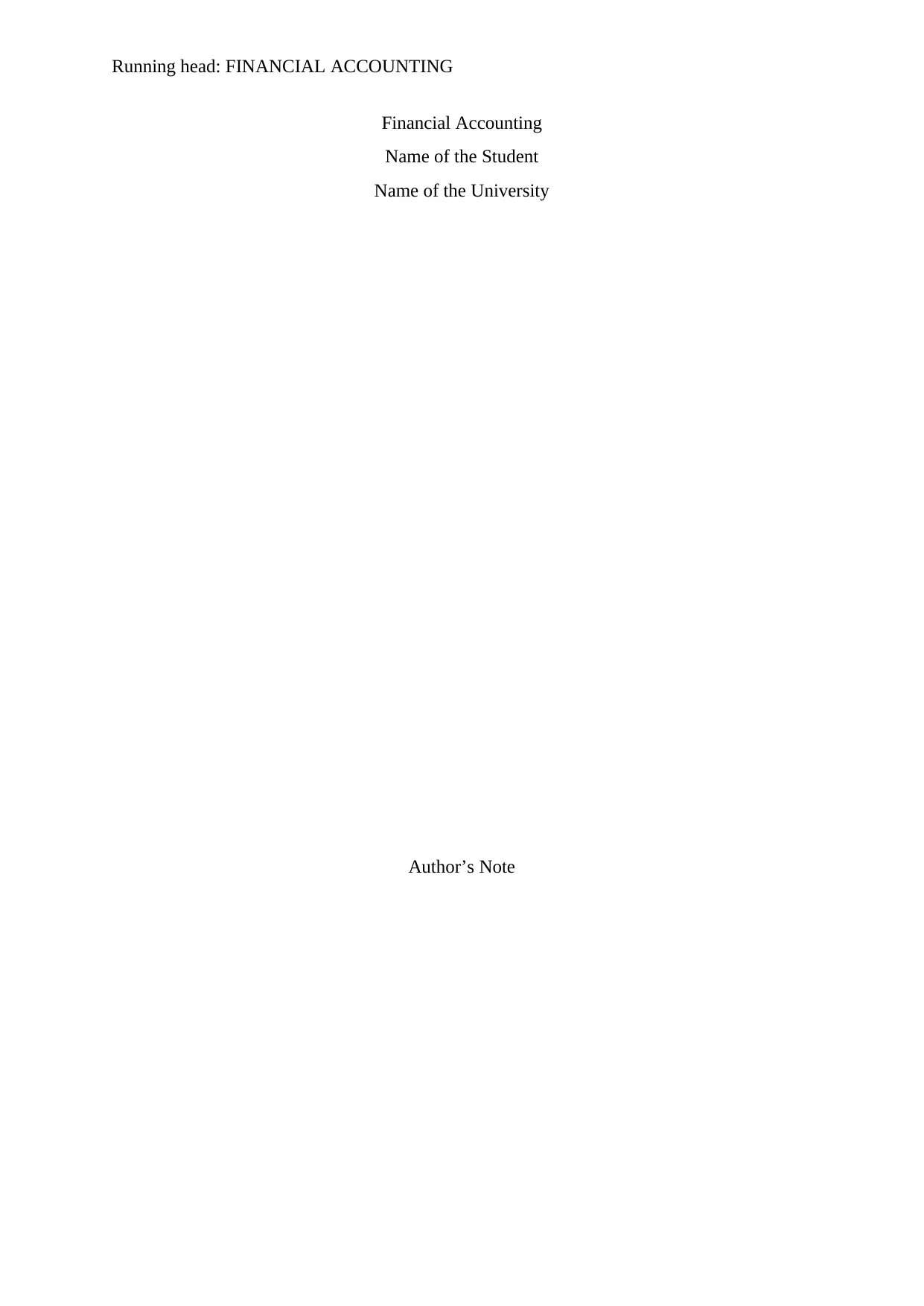
Running head: FINANCIAL ACCOUNTING
Financial Accounting
Name of the Student
Name of the University
Author’s Note
Financial Accounting
Name of the Student
Name of the University
Author’s Note
Paraphrase This Document
Need a fresh take? Get an instant paraphrase of this document with our AI Paraphraser
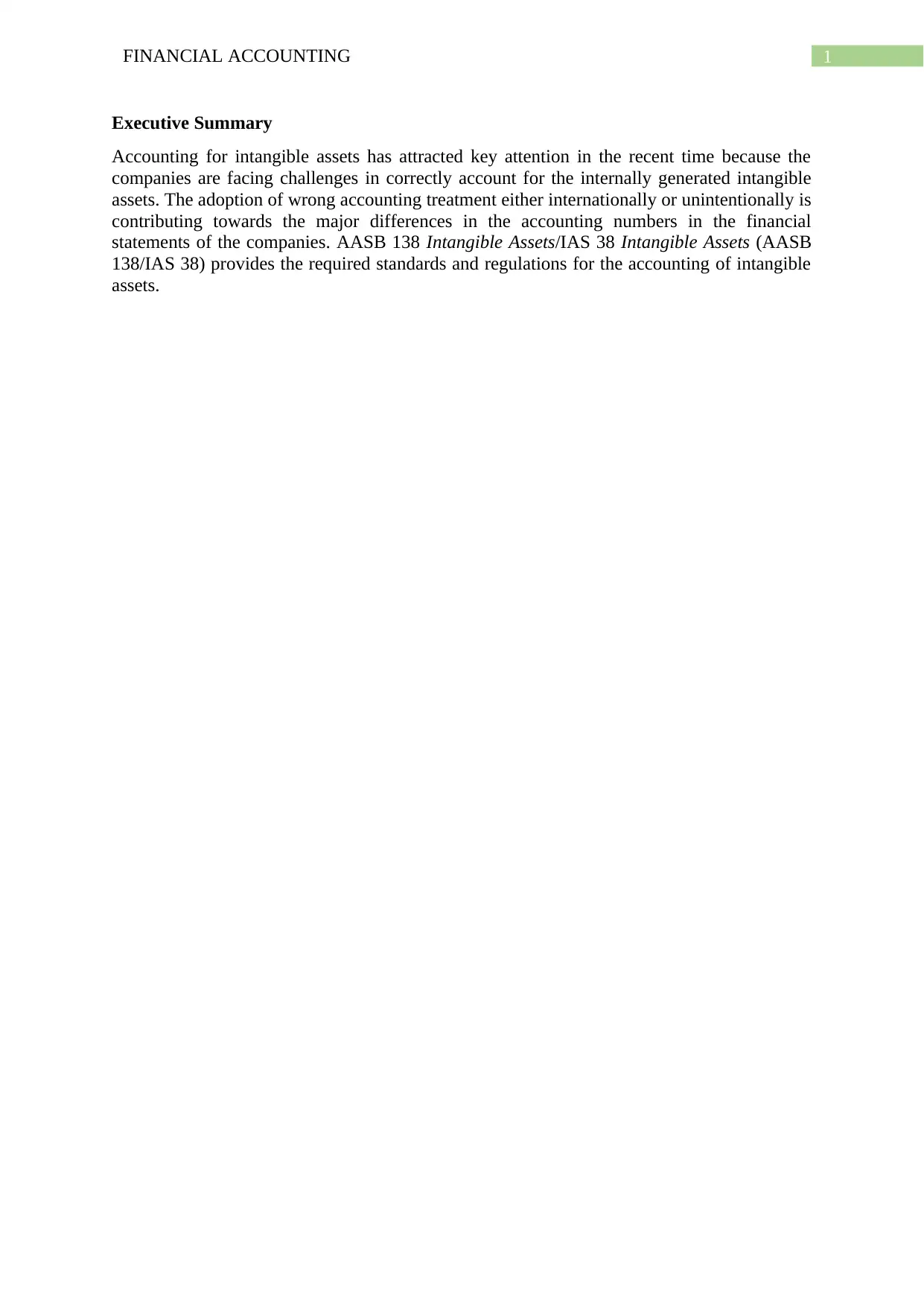
1FINANCIAL ACCOUNTING
Executive Summary
Accounting for intangible assets has attracted key attention in the recent time because the
companies are facing challenges in correctly account for the internally generated intangible
assets. The adoption of wrong accounting treatment either internationally or unintentionally is
contributing towards the major differences in the accounting numbers in the financial
statements of the companies. AASB 138 Intangible Assets/IAS 38 Intangible Assets (AASB
138/IAS 38) provides the required standards and regulations for the accounting of intangible
assets.
Executive Summary
Accounting for intangible assets has attracted key attention in the recent time because the
companies are facing challenges in correctly account for the internally generated intangible
assets. The adoption of wrong accounting treatment either internationally or unintentionally is
contributing towards the major differences in the accounting numbers in the financial
statements of the companies. AASB 138 Intangible Assets/IAS 38 Intangible Assets (AASB
138/IAS 38) provides the required standards and regulations for the accounting of intangible
assets.
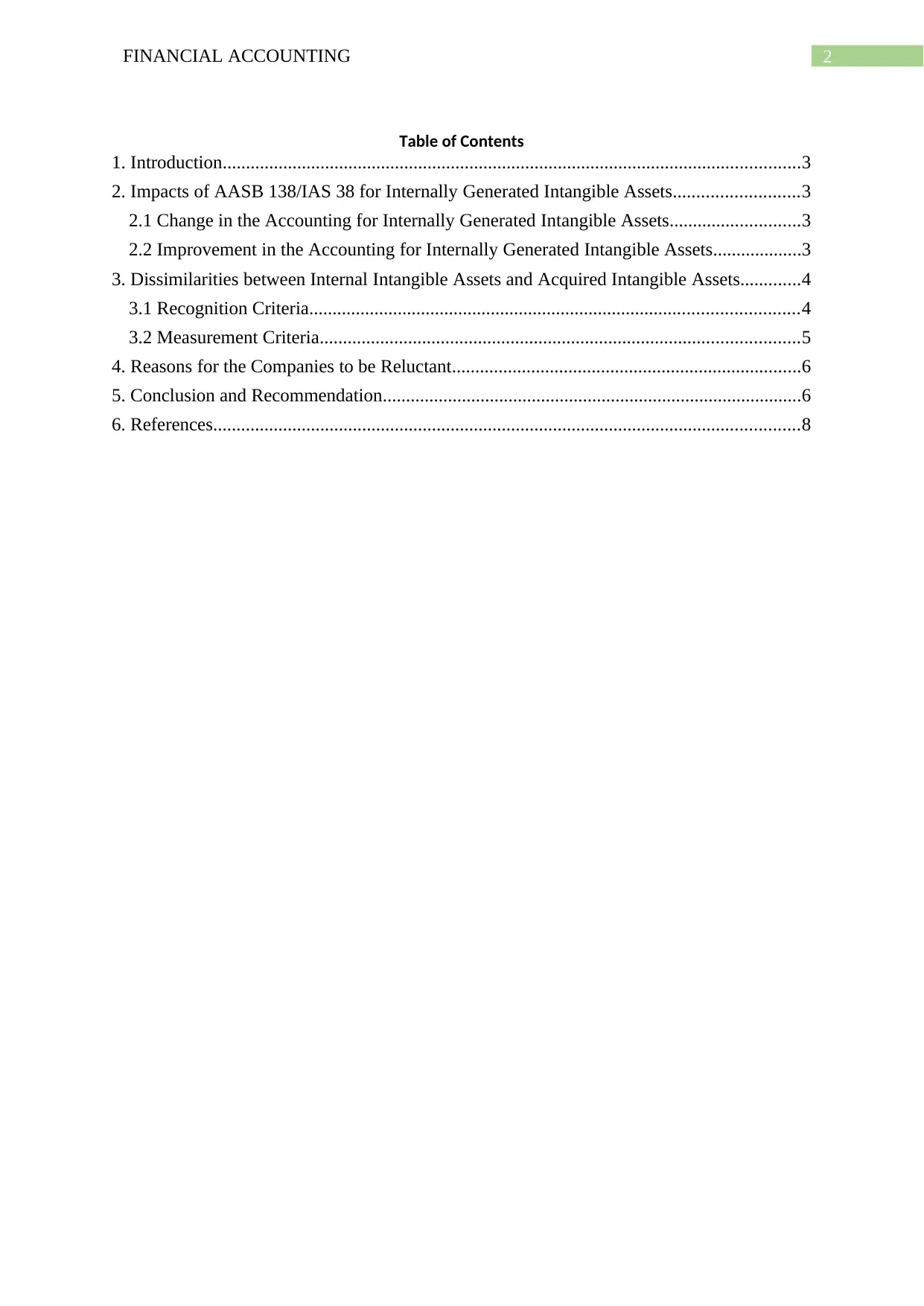
2FINANCIAL ACCOUNTING
Table of Contents
1. Introduction............................................................................................................................3
2. Impacts of AASB 138/IAS 38 for Internally Generated Intangible Assets...........................3
2.1 Change in the Accounting for Internally Generated Intangible Assets............................3
2.2 Improvement in the Accounting for Internally Generated Intangible Assets...................3
3. Dissimilarities between Internal Intangible Assets and Acquired Intangible Assets.............4
3.1 Recognition Criteria.........................................................................................................4
3.2 Measurement Criteria.......................................................................................................5
4. Reasons for the Companies to be Reluctant...........................................................................6
5. Conclusion and Recommendation..........................................................................................6
6. References..............................................................................................................................8
Table of Contents
1. Introduction............................................................................................................................3
2. Impacts of AASB 138/IAS 38 for Internally Generated Intangible Assets...........................3
2.1 Change in the Accounting for Internally Generated Intangible Assets............................3
2.2 Improvement in the Accounting for Internally Generated Intangible Assets...................3
3. Dissimilarities between Internal Intangible Assets and Acquired Intangible Assets.............4
3.1 Recognition Criteria.........................................................................................................4
3.2 Measurement Criteria.......................................................................................................5
4. Reasons for the Companies to be Reluctant...........................................................................6
5. Conclusion and Recommendation..........................................................................................6
6. References..............................................................................................................................8
⊘ This is a preview!⊘
Do you want full access?
Subscribe today to unlock all pages.

Trusted by 1+ million students worldwide
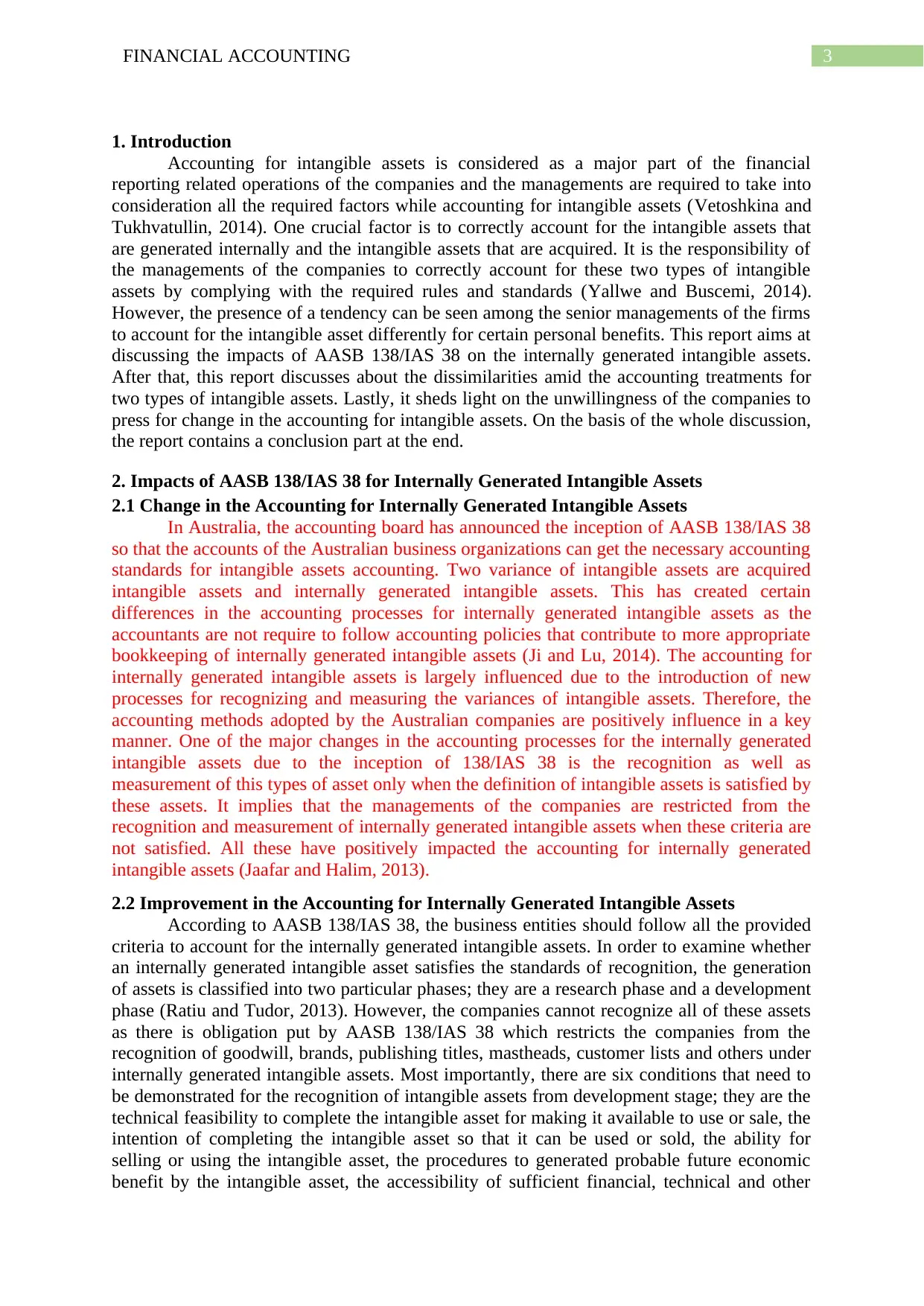
3FINANCIAL ACCOUNTING
1. Introduction
Accounting for intangible assets is considered as a major part of the financial
reporting related operations of the companies and the managements are required to take into
consideration all the required factors while accounting for intangible assets (Vetoshkina and
Tukhvatullin, 2014). One crucial factor is to correctly account for the intangible assets that
are generated internally and the intangible assets that are acquired. It is the responsibility of
the managements of the companies to correctly account for these two types of intangible
assets by complying with the required rules and standards (Yallwe and Buscemi, 2014).
However, the presence of a tendency can be seen among the senior managements of the firms
to account for the intangible asset differently for certain personal benefits. This report aims at
discussing the impacts of AASB 138/IAS 38 on the internally generated intangible assets.
After that, this report discusses about the dissimilarities amid the accounting treatments for
two types of intangible assets. Lastly, it sheds light on the unwillingness of the companies to
press for change in the accounting for intangible assets. On the basis of the whole discussion,
the report contains a conclusion part at the end.
2. Impacts of AASB 138/IAS 38 for Internally Generated Intangible Assets
2.1 Change in the Accounting for Internally Generated Intangible Assets
In Australia, the accounting board has announced the inception of AASB 138/IAS 38
so that the accounts of the Australian business organizations can get the necessary accounting
standards for intangible assets accounting. Two variance of intangible assets are acquired
intangible assets and internally generated intangible assets. This has created certain
differences in the accounting processes for internally generated intangible assets as the
accountants are not require to follow accounting policies that contribute to more appropriate
bookkeeping of internally generated intangible assets (Ji and Lu, 2014). The accounting for
internally generated intangible assets is largely influenced due to the introduction of new
processes for recognizing and measuring the variances of intangible assets. Therefore, the
accounting methods adopted by the Australian companies are positively influence in a key
manner. One of the major changes in the accounting processes for the internally generated
intangible assets due to the inception of 138/IAS 38 is the recognition as well as
measurement of this types of asset only when the definition of intangible assets is satisfied by
these assets. It implies that the managements of the companies are restricted from the
recognition and measurement of internally generated intangible assets when these criteria are
not satisfied. All these have positively impacted the accounting for internally generated
intangible assets (Jaafar and Halim, 2013).
2.2 Improvement in the Accounting for Internally Generated Intangible Assets
According to AASB 138/IAS 38, the business entities should follow all the provided
criteria to account for the internally generated intangible assets. In order to examine whether
an internally generated intangible asset satisfies the standards of recognition, the generation
of assets is classified into two particular phases; they are a research phase and a development
phase (Ratiu and Tudor, 2013). However, the companies cannot recognize all of these assets
as there is obligation put by AASB 138/IAS 38 which restricts the companies from the
recognition of goodwill, brands, publishing titles, mastheads, customer lists and others under
internally generated intangible assets. Most importantly, there are six conditions that need to
be demonstrated for the recognition of intangible assets from development stage; they are the
technical feasibility to complete the intangible asset for making it available to use or sale, the
intention of completing the intangible asset so that it can be used or sold, the ability for
selling or using the intangible asset, the procedures to generated probable future economic
benefit by the intangible asset, the accessibility of sufficient financial, technical and other
1. Introduction
Accounting for intangible assets is considered as a major part of the financial
reporting related operations of the companies and the managements are required to take into
consideration all the required factors while accounting for intangible assets (Vetoshkina and
Tukhvatullin, 2014). One crucial factor is to correctly account for the intangible assets that
are generated internally and the intangible assets that are acquired. It is the responsibility of
the managements of the companies to correctly account for these two types of intangible
assets by complying with the required rules and standards (Yallwe and Buscemi, 2014).
However, the presence of a tendency can be seen among the senior managements of the firms
to account for the intangible asset differently for certain personal benefits. This report aims at
discussing the impacts of AASB 138/IAS 38 on the internally generated intangible assets.
After that, this report discusses about the dissimilarities amid the accounting treatments for
two types of intangible assets. Lastly, it sheds light on the unwillingness of the companies to
press for change in the accounting for intangible assets. On the basis of the whole discussion,
the report contains a conclusion part at the end.
2. Impacts of AASB 138/IAS 38 for Internally Generated Intangible Assets
2.1 Change in the Accounting for Internally Generated Intangible Assets
In Australia, the accounting board has announced the inception of AASB 138/IAS 38
so that the accounts of the Australian business organizations can get the necessary accounting
standards for intangible assets accounting. Two variance of intangible assets are acquired
intangible assets and internally generated intangible assets. This has created certain
differences in the accounting processes for internally generated intangible assets as the
accountants are not require to follow accounting policies that contribute to more appropriate
bookkeeping of internally generated intangible assets (Ji and Lu, 2014). The accounting for
internally generated intangible assets is largely influenced due to the introduction of new
processes for recognizing and measuring the variances of intangible assets. Therefore, the
accounting methods adopted by the Australian companies are positively influence in a key
manner. One of the major changes in the accounting processes for the internally generated
intangible assets due to the inception of 138/IAS 38 is the recognition as well as
measurement of this types of asset only when the definition of intangible assets is satisfied by
these assets. It implies that the managements of the companies are restricted from the
recognition and measurement of internally generated intangible assets when these criteria are
not satisfied. All these have positively impacted the accounting for internally generated
intangible assets (Jaafar and Halim, 2013).
2.2 Improvement in the Accounting for Internally Generated Intangible Assets
According to AASB 138/IAS 38, the business entities should follow all the provided
criteria to account for the internally generated intangible assets. In order to examine whether
an internally generated intangible asset satisfies the standards of recognition, the generation
of assets is classified into two particular phases; they are a research phase and a development
phase (Ratiu and Tudor, 2013). However, the companies cannot recognize all of these assets
as there is obligation put by AASB 138/IAS 38 which restricts the companies from the
recognition of goodwill, brands, publishing titles, mastheads, customer lists and others under
internally generated intangible assets. Most importantly, there are six conditions that need to
be demonstrated for the recognition of intangible assets from development stage; they are the
technical feasibility to complete the intangible asset for making it available to use or sale, the
intention of completing the intangible asset so that it can be used or sold, the ability for
selling or using the intangible asset, the procedures to generated probable future economic
benefit by the intangible asset, the accessibility of sufficient financial, technical and other
Paraphrase This Document
Need a fresh take? Get an instant paraphrase of this document with our AI Paraphraser
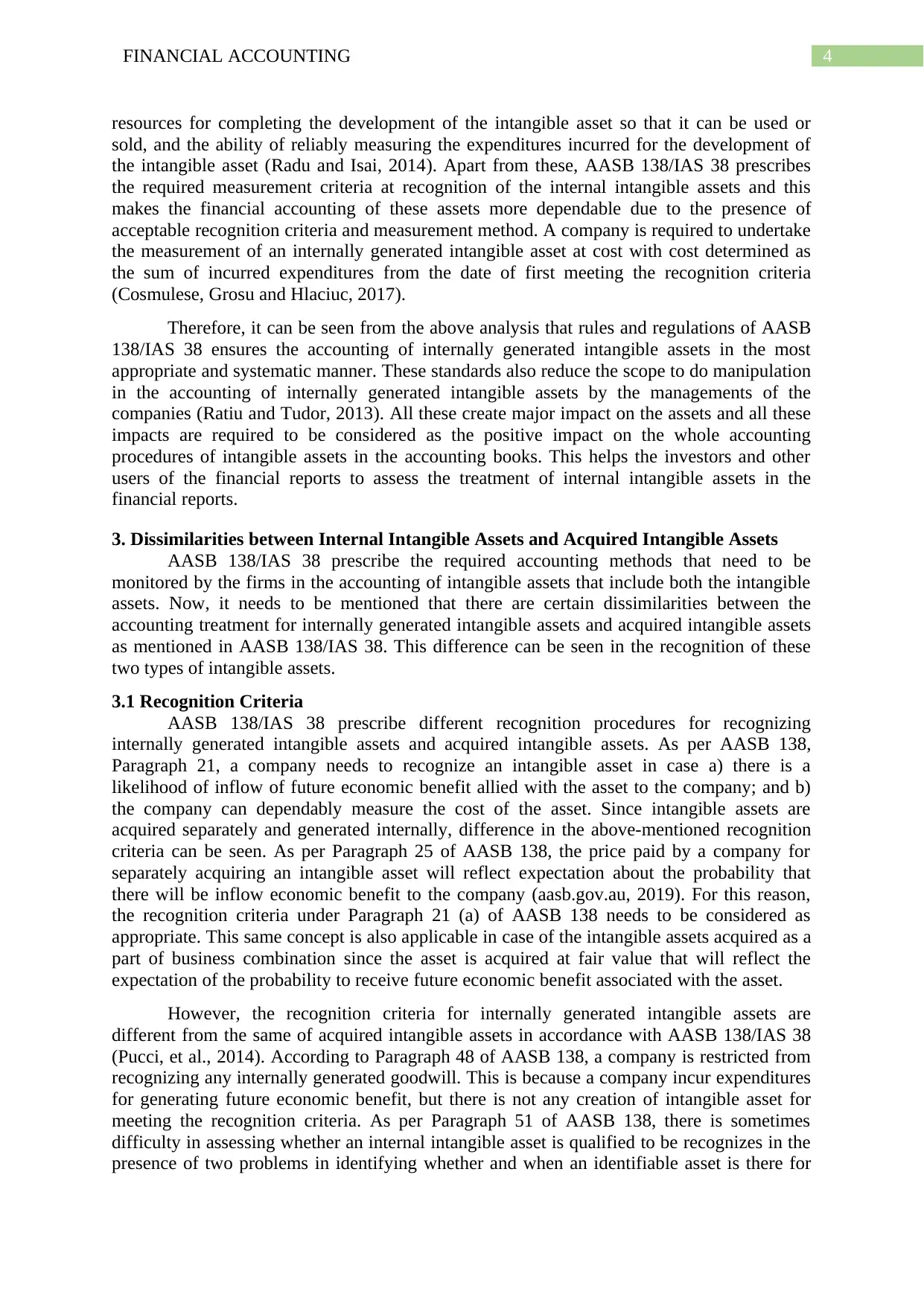
4FINANCIAL ACCOUNTING
resources for completing the development of the intangible asset so that it can be used or
sold, and the ability of reliably measuring the expenditures incurred for the development of
the intangible asset (Radu and Isai, 2014). Apart from these, AASB 138/IAS 38 prescribes
the required measurement criteria at recognition of the internal intangible assets and this
makes the financial accounting of these assets more dependable due to the presence of
acceptable recognition criteria and measurement method. A company is required to undertake
the measurement of an internally generated intangible asset at cost with cost determined as
the sum of incurred expenditures from the date of first meeting the recognition criteria
(Cosmulese, Grosu and Hlaciuc, 2017).
Therefore, it can be seen from the above analysis that rules and regulations of AASB
138/IAS 38 ensures the accounting of internally generated intangible assets in the most
appropriate and systematic manner. These standards also reduce the scope to do manipulation
in the accounting of internally generated intangible assets by the managements of the
companies (Ratiu and Tudor, 2013). All these create major impact on the assets and all these
impacts are required to be considered as the positive impact on the whole accounting
procedures of intangible assets in the accounting books. This helps the investors and other
users of the financial reports to assess the treatment of internal intangible assets in the
financial reports.
3. Dissimilarities between Internal Intangible Assets and Acquired Intangible Assets
AASB 138/IAS 38 prescribe the required accounting methods that need to be
monitored by the firms in the accounting of intangible assets that include both the intangible
assets. Now, it needs to be mentioned that there are certain dissimilarities between the
accounting treatment for internally generated intangible assets and acquired intangible assets
as mentioned in AASB 138/IAS 38. This difference can be seen in the recognition of these
two types of intangible assets.
3.1 Recognition Criteria
AASB 138/IAS 38 prescribe different recognition procedures for recognizing
internally generated intangible assets and acquired intangible assets. As per AASB 138,
Paragraph 21, a company needs to recognize an intangible asset in case a) there is a
likelihood of inflow of future economic benefit allied with the asset to the company; and b)
the company can dependably measure the cost of the asset. Since intangible assets are
acquired separately and generated internally, difference in the above-mentioned recognition
criteria can be seen. As per Paragraph 25 of AASB 138, the price paid by a company for
separately acquiring an intangible asset will reflect expectation about the probability that
there will be inflow economic benefit to the company (aasb.gov.au, 2019). For this reason,
the recognition criteria under Paragraph 21 (a) of AASB 138 needs to be considered as
appropriate. This same concept is also applicable in case of the intangible assets acquired as a
part of business combination since the asset is acquired at fair value that will reflect the
expectation of the probability to receive future economic benefit associated with the asset.
However, the recognition criteria for internally generated intangible assets are
different from the same of acquired intangible assets in accordance with AASB 138/IAS 38
(Pucci, et al., 2014). According to Paragraph 48 of AASB 138, a company is restricted from
recognizing any internally generated goodwill. This is because a company incur expenditures
for generating future economic benefit, but there is not any creation of intangible asset for
meeting the recognition criteria. As per Paragraph 51 of AASB 138, there is sometimes
difficulty in assessing whether an internal intangible asset is qualified to be recognizes in the
presence of two problems in identifying whether and when an identifiable asset is there for
resources for completing the development of the intangible asset so that it can be used or
sold, and the ability of reliably measuring the expenditures incurred for the development of
the intangible asset (Radu and Isai, 2014). Apart from these, AASB 138/IAS 38 prescribes
the required measurement criteria at recognition of the internal intangible assets and this
makes the financial accounting of these assets more dependable due to the presence of
acceptable recognition criteria and measurement method. A company is required to undertake
the measurement of an internally generated intangible asset at cost with cost determined as
the sum of incurred expenditures from the date of first meeting the recognition criteria
(Cosmulese, Grosu and Hlaciuc, 2017).
Therefore, it can be seen from the above analysis that rules and regulations of AASB
138/IAS 38 ensures the accounting of internally generated intangible assets in the most
appropriate and systematic manner. These standards also reduce the scope to do manipulation
in the accounting of internally generated intangible assets by the managements of the
companies (Ratiu and Tudor, 2013). All these create major impact on the assets and all these
impacts are required to be considered as the positive impact on the whole accounting
procedures of intangible assets in the accounting books. This helps the investors and other
users of the financial reports to assess the treatment of internal intangible assets in the
financial reports.
3. Dissimilarities between Internal Intangible Assets and Acquired Intangible Assets
AASB 138/IAS 38 prescribe the required accounting methods that need to be
monitored by the firms in the accounting of intangible assets that include both the intangible
assets. Now, it needs to be mentioned that there are certain dissimilarities between the
accounting treatment for internally generated intangible assets and acquired intangible assets
as mentioned in AASB 138/IAS 38. This difference can be seen in the recognition of these
two types of intangible assets.
3.1 Recognition Criteria
AASB 138/IAS 38 prescribe different recognition procedures for recognizing
internally generated intangible assets and acquired intangible assets. As per AASB 138,
Paragraph 21, a company needs to recognize an intangible asset in case a) there is a
likelihood of inflow of future economic benefit allied with the asset to the company; and b)
the company can dependably measure the cost of the asset. Since intangible assets are
acquired separately and generated internally, difference in the above-mentioned recognition
criteria can be seen. As per Paragraph 25 of AASB 138, the price paid by a company for
separately acquiring an intangible asset will reflect expectation about the probability that
there will be inflow economic benefit to the company (aasb.gov.au, 2019). For this reason,
the recognition criteria under Paragraph 21 (a) of AASB 138 needs to be considered as
appropriate. This same concept is also applicable in case of the intangible assets acquired as a
part of business combination since the asset is acquired at fair value that will reflect the
expectation of the probability to receive future economic benefit associated with the asset.
However, the recognition criteria for internally generated intangible assets are
different from the same of acquired intangible assets in accordance with AASB 138/IAS 38
(Pucci, et al., 2014). According to Paragraph 48 of AASB 138, a company is restricted from
recognizing any internally generated goodwill. This is because a company incur expenditures
for generating future economic benefit, but there is not any creation of intangible asset for
meeting the recognition criteria. As per Paragraph 51 of AASB 138, there is sometimes
difficulty in assessing whether an internal intangible asset is qualified to be recognizes in the
presence of two problems in identifying whether and when an identifiable asset is there for
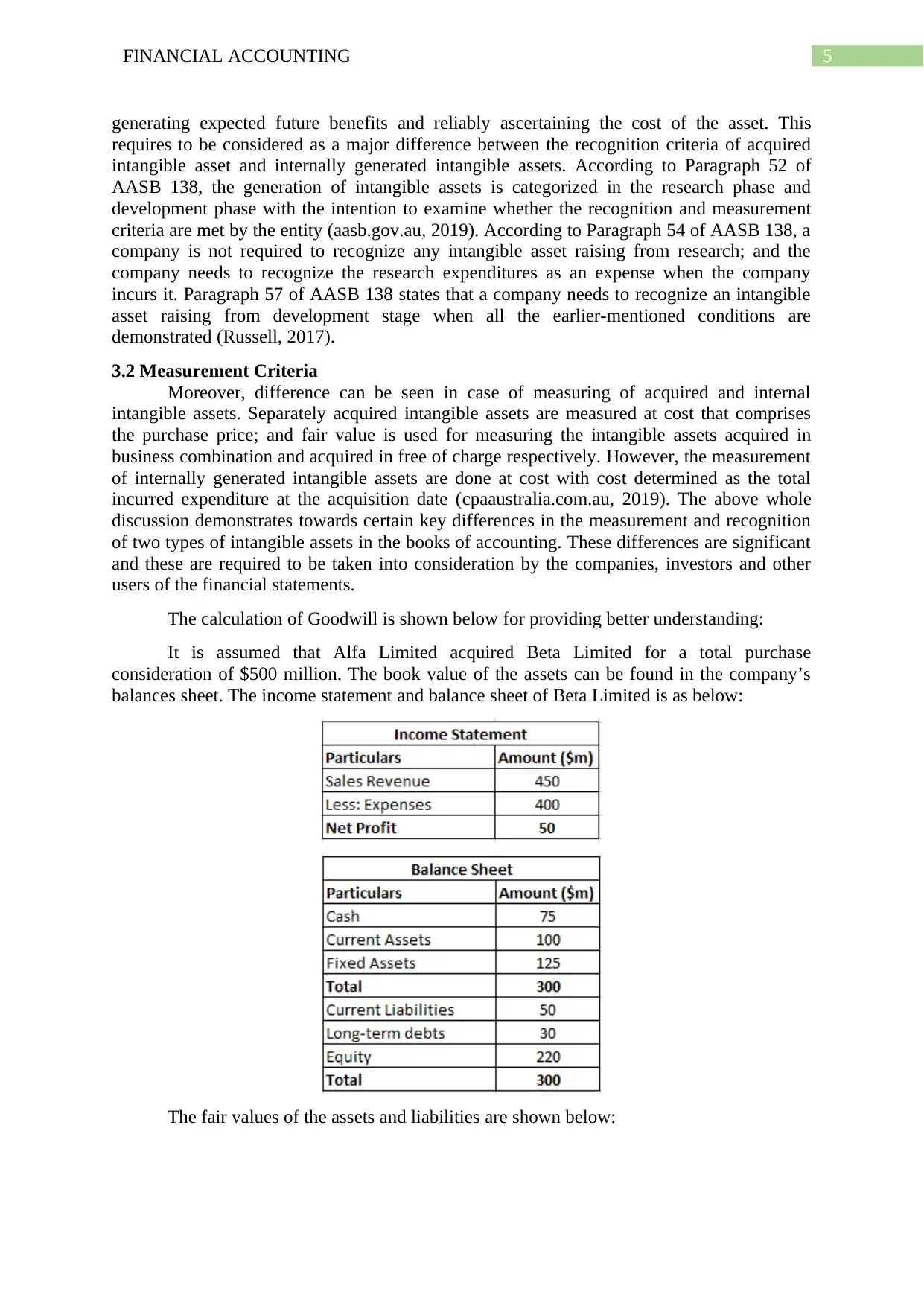
5FINANCIAL ACCOUNTING
generating expected future benefits and reliably ascertaining the cost of the asset. This
requires to be considered as a major difference between the recognition criteria of acquired
intangible asset and internally generated intangible assets. According to Paragraph 52 of
AASB 138, the generation of intangible assets is categorized in the research phase and
development phase with the intention to examine whether the recognition and measurement
criteria are met by the entity (aasb.gov.au, 2019). According to Paragraph 54 of AASB 138, a
company is not required to recognize any intangible asset raising from research; and the
company needs to recognize the research expenditures as an expense when the company
incurs it. Paragraph 57 of AASB 138 states that a company needs to recognize an intangible
asset raising from development stage when all the earlier-mentioned conditions are
demonstrated (Russell, 2017).
3.2 Measurement Criteria
Moreover, difference can be seen in case of measuring of acquired and internal
intangible assets. Separately acquired intangible assets are measured at cost that comprises
the purchase price; and fair value is used for measuring the intangible assets acquired in
business combination and acquired in free of charge respectively. However, the measurement
of internally generated intangible assets are done at cost with cost determined as the total
incurred expenditure at the acquisition date (cpaaustralia.com.au, 2019). The above whole
discussion demonstrates towards certain key differences in the measurement and recognition
of two types of intangible assets in the books of accounting. These differences are significant
and these are required to be taken into consideration by the companies, investors and other
users of the financial statements.
The calculation of Goodwill is shown below for providing better understanding:
It is assumed that Alfa Limited acquired Beta Limited for a total purchase
consideration of $500 million. The book value of the assets can be found in the company’s
balances sheet. The income statement and balance sheet of Beta Limited is as below:
The fair values of the assets and liabilities are shown below:
generating expected future benefits and reliably ascertaining the cost of the asset. This
requires to be considered as a major difference between the recognition criteria of acquired
intangible asset and internally generated intangible assets. According to Paragraph 52 of
AASB 138, the generation of intangible assets is categorized in the research phase and
development phase with the intention to examine whether the recognition and measurement
criteria are met by the entity (aasb.gov.au, 2019). According to Paragraph 54 of AASB 138, a
company is not required to recognize any intangible asset raising from research; and the
company needs to recognize the research expenditures as an expense when the company
incurs it. Paragraph 57 of AASB 138 states that a company needs to recognize an intangible
asset raising from development stage when all the earlier-mentioned conditions are
demonstrated (Russell, 2017).
3.2 Measurement Criteria
Moreover, difference can be seen in case of measuring of acquired and internal
intangible assets. Separately acquired intangible assets are measured at cost that comprises
the purchase price; and fair value is used for measuring the intangible assets acquired in
business combination and acquired in free of charge respectively. However, the measurement
of internally generated intangible assets are done at cost with cost determined as the total
incurred expenditure at the acquisition date (cpaaustralia.com.au, 2019). The above whole
discussion demonstrates towards certain key differences in the measurement and recognition
of two types of intangible assets in the books of accounting. These differences are significant
and these are required to be taken into consideration by the companies, investors and other
users of the financial statements.
The calculation of Goodwill is shown below for providing better understanding:
It is assumed that Alfa Limited acquired Beta Limited for a total purchase
consideration of $500 million. The book value of the assets can be found in the company’s
balances sheet. The income statement and balance sheet of Beta Limited is as below:
The fair values of the assets and liabilities are shown below:
⊘ This is a preview!⊘
Do you want full access?
Subscribe today to unlock all pages.

Trusted by 1+ million students worldwide
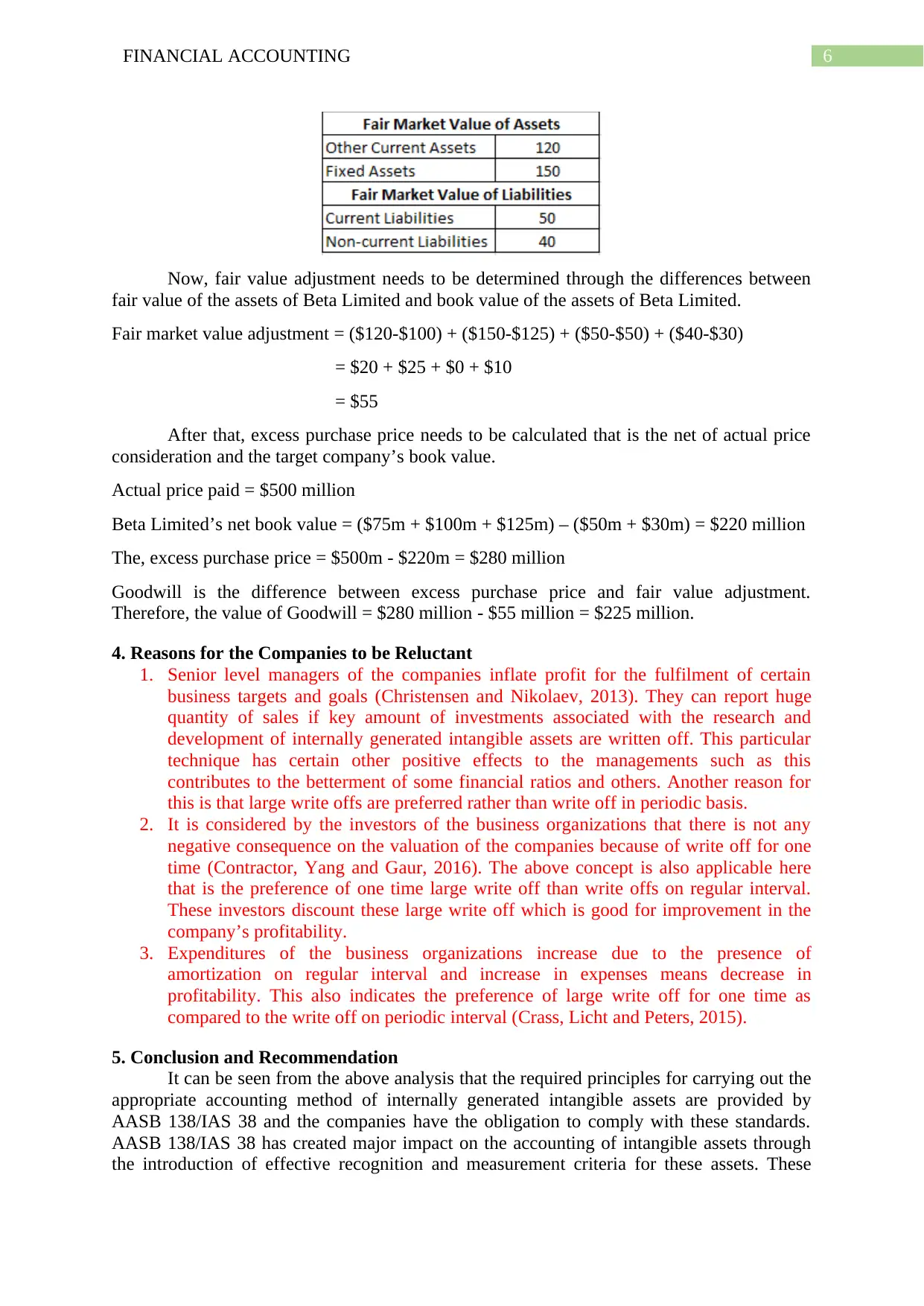
6FINANCIAL ACCOUNTING
Now, fair value adjustment needs to be determined through the differences between
fair value of the assets of Beta Limited and book value of the assets of Beta Limited.
Fair market value adjustment = ($120-$100) + ($150-$125) + ($50-$50) + ($40-$30)
= $20 + $25 + $0 + $10
= $55
After that, excess purchase price needs to be calculated that is the net of actual price
consideration and the target company’s book value.
Actual price paid = $500 million
Beta Limited’s net book value = ($75m + $100m + $125m) – ($50m + $30m) = $220 million
The, excess purchase price = $500m - $220m = $280 million
Goodwill is the difference between excess purchase price and fair value adjustment.
Therefore, the value of Goodwill = $280 million - $55 million = $225 million.
4. Reasons for the Companies to be Reluctant
1. Senior level managers of the companies inflate profit for the fulfilment of certain
business targets and goals (Christensen and Nikolaev, 2013). They can report huge
quantity of sales if key amount of investments associated with the research and
development of internally generated intangible assets are written off. This particular
technique has certain other positive effects to the managements such as this
contributes to the betterment of some financial ratios and others. Another reason for
this is that large write offs are preferred rather than write off in periodic basis.
2. It is considered by the investors of the business organizations that there is not any
negative consequence on the valuation of the companies because of write off for one
time (Contractor, Yang and Gaur, 2016). The above concept is also applicable here
that is the preference of one time large write off than write offs on regular interval.
These investors discount these large write off which is good for improvement in the
company’s profitability.
3. Expenditures of the business organizations increase due to the presence of
amortization on regular interval and increase in expenses means decrease in
profitability. This also indicates the preference of large write off for one time as
compared to the write off on periodic interval (Crass, Licht and Peters, 2015).
5. Conclusion and Recommendation
It can be seen from the above analysis that the required principles for carrying out the
appropriate accounting method of internally generated intangible assets are provided by
AASB 138/IAS 38 and the companies have the obligation to comply with these standards.
AASB 138/IAS 38 has created major impact on the accounting of intangible assets through
the introduction of effective recognition and measurement criteria for these assets. These
Now, fair value adjustment needs to be determined through the differences between
fair value of the assets of Beta Limited and book value of the assets of Beta Limited.
Fair market value adjustment = ($120-$100) + ($150-$125) + ($50-$50) + ($40-$30)
= $20 + $25 + $0 + $10
= $55
After that, excess purchase price needs to be calculated that is the net of actual price
consideration and the target company’s book value.
Actual price paid = $500 million
Beta Limited’s net book value = ($75m + $100m + $125m) – ($50m + $30m) = $220 million
The, excess purchase price = $500m - $220m = $280 million
Goodwill is the difference between excess purchase price and fair value adjustment.
Therefore, the value of Goodwill = $280 million - $55 million = $225 million.
4. Reasons for the Companies to be Reluctant
1. Senior level managers of the companies inflate profit for the fulfilment of certain
business targets and goals (Christensen and Nikolaev, 2013). They can report huge
quantity of sales if key amount of investments associated with the research and
development of internally generated intangible assets are written off. This particular
technique has certain other positive effects to the managements such as this
contributes to the betterment of some financial ratios and others. Another reason for
this is that large write offs are preferred rather than write off in periodic basis.
2. It is considered by the investors of the business organizations that there is not any
negative consequence on the valuation of the companies because of write off for one
time (Contractor, Yang and Gaur, 2016). The above concept is also applicable here
that is the preference of one time large write off than write offs on regular interval.
These investors discount these large write off which is good for improvement in the
company’s profitability.
3. Expenditures of the business organizations increase due to the presence of
amortization on regular interval and increase in expenses means decrease in
profitability. This also indicates the preference of large write off for one time as
compared to the write off on periodic interval (Crass, Licht and Peters, 2015).
5. Conclusion and Recommendation
It can be seen from the above analysis that the required principles for carrying out the
appropriate accounting method of internally generated intangible assets are provided by
AASB 138/IAS 38 and the companies have the obligation to comply with these standards.
AASB 138/IAS 38 has created major impact on the accounting of intangible assets through
the introduction of effective recognition and measurement criteria for these assets. These
Paraphrase This Document
Need a fresh take? Get an instant paraphrase of this document with our AI Paraphraser
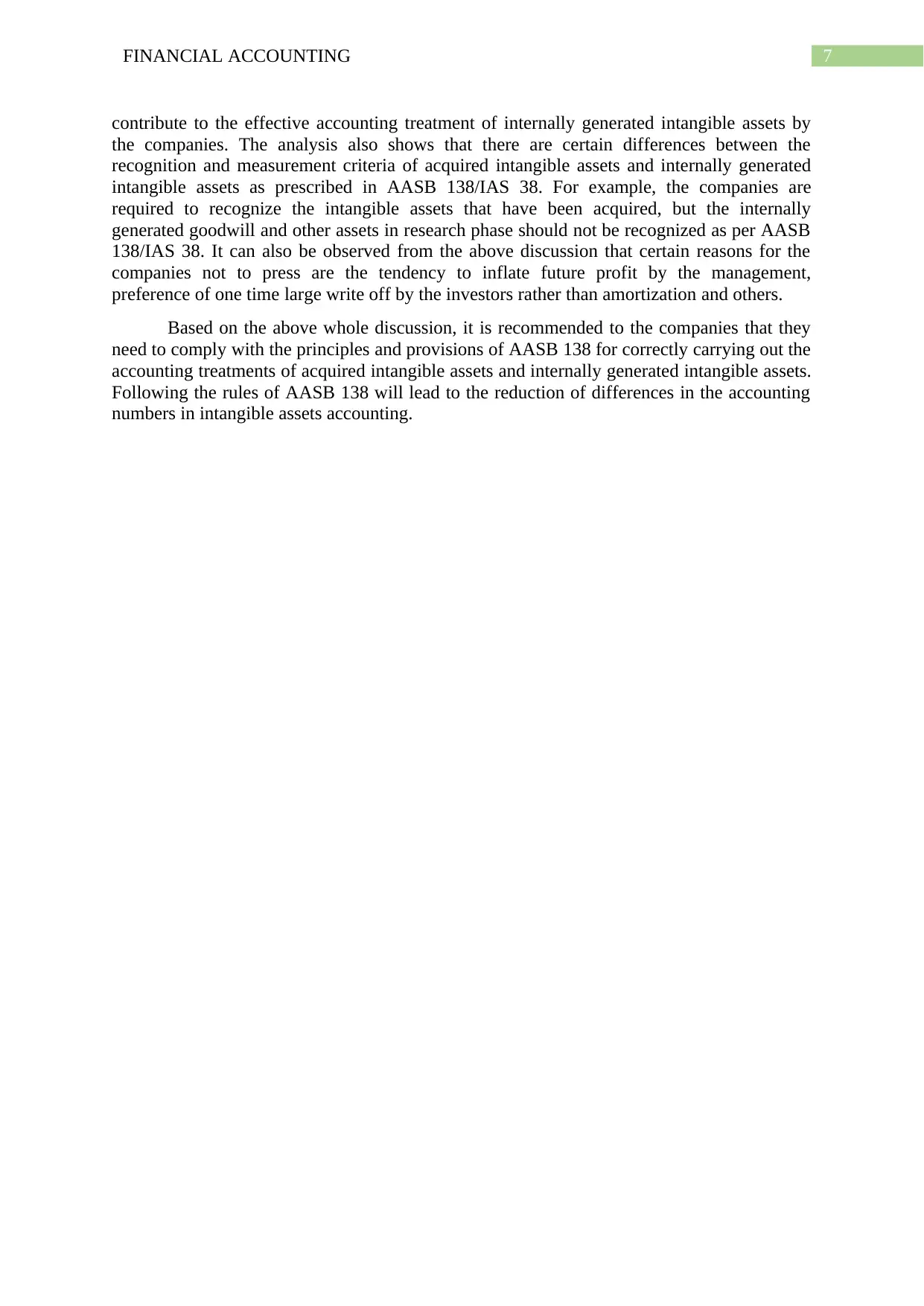
7FINANCIAL ACCOUNTING
contribute to the effective accounting treatment of internally generated intangible assets by
the companies. The analysis also shows that there are certain differences between the
recognition and measurement criteria of acquired intangible assets and internally generated
intangible assets as prescribed in AASB 138/IAS 38. For example, the companies are
required to recognize the intangible assets that have been acquired, but the internally
generated goodwill and other assets in research phase should not be recognized as per AASB
138/IAS 38. It can also be observed from the above discussion that certain reasons for the
companies not to press are the tendency to inflate future profit by the management,
preference of one time large write off by the investors rather than amortization and others.
Based on the above whole discussion, it is recommended to the companies that they
need to comply with the principles and provisions of AASB 138 for correctly carrying out the
accounting treatments of acquired intangible assets and internally generated intangible assets.
Following the rules of AASB 138 will lead to the reduction of differences in the accounting
numbers in intangible assets accounting.
contribute to the effective accounting treatment of internally generated intangible assets by
the companies. The analysis also shows that there are certain differences between the
recognition and measurement criteria of acquired intangible assets and internally generated
intangible assets as prescribed in AASB 138/IAS 38. For example, the companies are
required to recognize the intangible assets that have been acquired, but the internally
generated goodwill and other assets in research phase should not be recognized as per AASB
138/IAS 38. It can also be observed from the above discussion that certain reasons for the
companies not to press are the tendency to inflate future profit by the management,
preference of one time large write off by the investors rather than amortization and others.
Based on the above whole discussion, it is recommended to the companies that they
need to comply with the principles and provisions of AASB 138 for correctly carrying out the
accounting treatments of acquired intangible assets and internally generated intangible assets.
Following the rules of AASB 138 will lead to the reduction of differences in the accounting
numbers in intangible assets accounting.
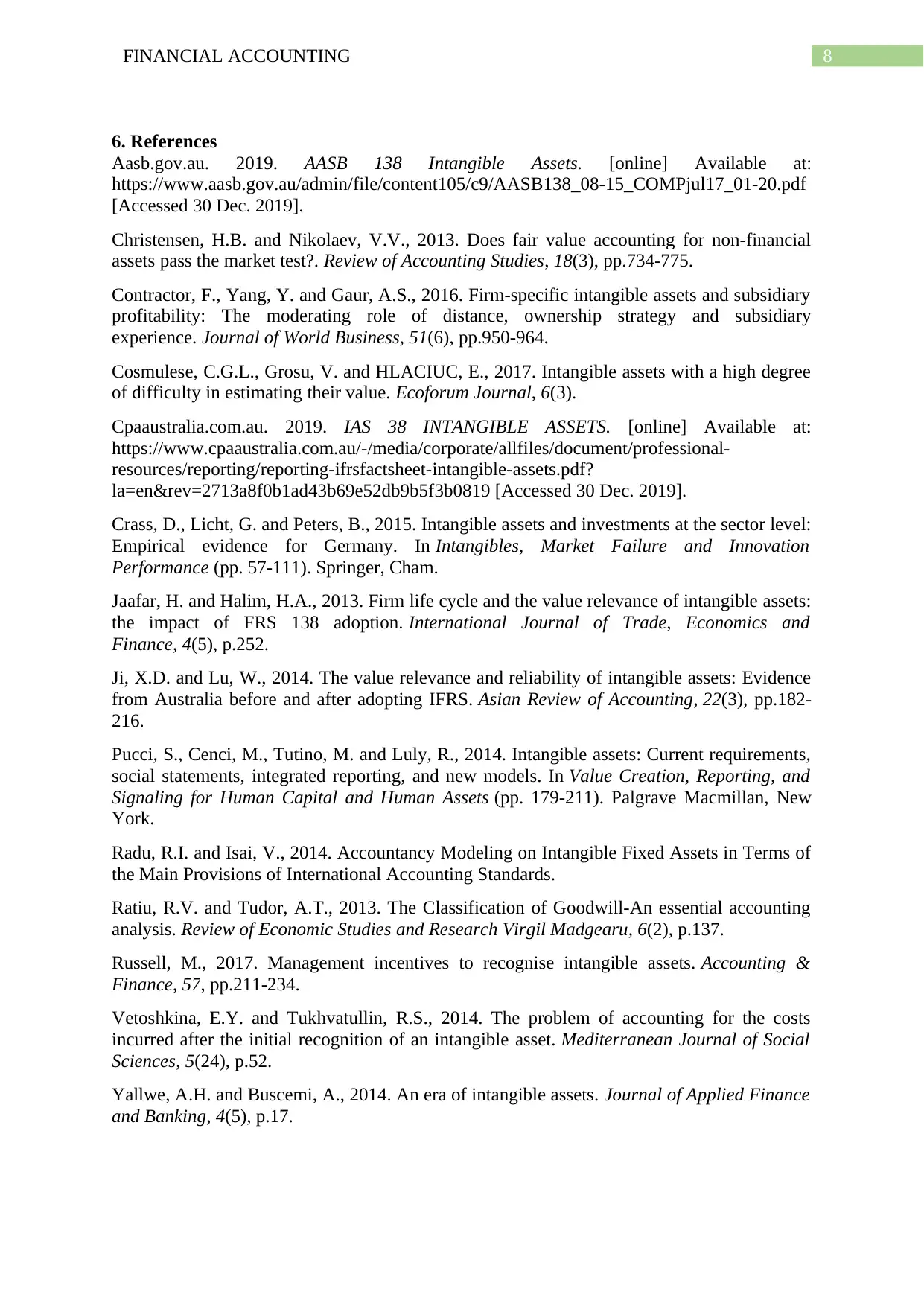
8FINANCIAL ACCOUNTING
6. References
Aasb.gov.au. 2019. AASB 138 Intangible Assets. [online] Available at:
https://www.aasb.gov.au/admin/file/content105/c9/AASB138_08-15_COMPjul17_01-20.pdf
[Accessed 30 Dec. 2019].
Christensen, H.B. and Nikolaev, V.V., 2013. Does fair value accounting for non-financial
assets pass the market test?. Review of Accounting Studies, 18(3), pp.734-775.
Contractor, F., Yang, Y. and Gaur, A.S., 2016. Firm-specific intangible assets and subsidiary
profitability: The moderating role of distance, ownership strategy and subsidiary
experience. Journal of World Business, 51(6), pp.950-964.
Cosmulese, C.G.L., Grosu, V. and HLACIUC, E., 2017. Intangible assets with a high degree
of difficulty in estimating their value. Ecoforum Journal, 6(3).
Cpaaustralia.com.au. 2019. IAS 38 INTANGIBLE ASSETS. [online] Available at:
https://www.cpaaustralia.com.au/-/media/corporate/allfiles/document/professional-
resources/reporting/reporting-ifrsfactsheet-intangible-assets.pdf?
la=en&rev=2713a8f0b1ad43b69e52db9b5f3b0819 [Accessed 30 Dec. 2019].
Crass, D., Licht, G. and Peters, B., 2015. Intangible assets and investments at the sector level:
Empirical evidence for Germany. In Intangibles, Market Failure and Innovation
Performance (pp. 57-111). Springer, Cham.
Jaafar, H. and Halim, H.A., 2013. Firm life cycle and the value relevance of intangible assets:
the impact of FRS 138 adoption. International Journal of Trade, Economics and
Finance, 4(5), p.252.
Ji, X.D. and Lu, W., 2014. The value relevance and reliability of intangible assets: Evidence
from Australia before and after adopting IFRS. Asian Review of Accounting, 22(3), pp.182-
216.
Pucci, S., Cenci, M., Tutino, M. and Luly, R., 2014. Intangible assets: Current requirements,
social statements, integrated reporting, and new models. In Value Creation, Reporting, and
Signaling for Human Capital and Human Assets (pp. 179-211). Palgrave Macmillan, New
York.
Radu, R.I. and Isai, V., 2014. Accountancy Modeling on Intangible Fixed Assets in Terms of
the Main Provisions of International Accounting Standards.
Ratiu, R.V. and Tudor, A.T., 2013. The Classification of Goodwill-An essential accounting
analysis. Review of Economic Studies and Research Virgil Madgearu, 6(2), p.137.
Russell, M., 2017. Management incentives to recognise intangible assets. Accounting &
Finance, 57, pp.211-234.
Vetoshkina, E.Y. and Tukhvatullin, R.S., 2014. The problem of accounting for the costs
incurred after the initial recognition of an intangible asset. Mediterranean Journal of Social
Sciences, 5(24), p.52.
Yallwe, A.H. and Buscemi, A., 2014. An era of intangible assets. Journal of Applied Finance
and Banking, 4(5), p.17.
6. References
Aasb.gov.au. 2019. AASB 138 Intangible Assets. [online] Available at:
https://www.aasb.gov.au/admin/file/content105/c9/AASB138_08-15_COMPjul17_01-20.pdf
[Accessed 30 Dec. 2019].
Christensen, H.B. and Nikolaev, V.V., 2013. Does fair value accounting for non-financial
assets pass the market test?. Review of Accounting Studies, 18(3), pp.734-775.
Contractor, F., Yang, Y. and Gaur, A.S., 2016. Firm-specific intangible assets and subsidiary
profitability: The moderating role of distance, ownership strategy and subsidiary
experience. Journal of World Business, 51(6), pp.950-964.
Cosmulese, C.G.L., Grosu, V. and HLACIUC, E., 2017. Intangible assets with a high degree
of difficulty in estimating their value. Ecoforum Journal, 6(3).
Cpaaustralia.com.au. 2019. IAS 38 INTANGIBLE ASSETS. [online] Available at:
https://www.cpaaustralia.com.au/-/media/corporate/allfiles/document/professional-
resources/reporting/reporting-ifrsfactsheet-intangible-assets.pdf?
la=en&rev=2713a8f0b1ad43b69e52db9b5f3b0819 [Accessed 30 Dec. 2019].
Crass, D., Licht, G. and Peters, B., 2015. Intangible assets and investments at the sector level:
Empirical evidence for Germany. In Intangibles, Market Failure and Innovation
Performance (pp. 57-111). Springer, Cham.
Jaafar, H. and Halim, H.A., 2013. Firm life cycle and the value relevance of intangible assets:
the impact of FRS 138 adoption. International Journal of Trade, Economics and
Finance, 4(5), p.252.
Ji, X.D. and Lu, W., 2014. The value relevance and reliability of intangible assets: Evidence
from Australia before and after adopting IFRS. Asian Review of Accounting, 22(3), pp.182-
216.
Pucci, S., Cenci, M., Tutino, M. and Luly, R., 2014. Intangible assets: Current requirements,
social statements, integrated reporting, and new models. In Value Creation, Reporting, and
Signaling for Human Capital and Human Assets (pp. 179-211). Palgrave Macmillan, New
York.
Radu, R.I. and Isai, V., 2014. Accountancy Modeling on Intangible Fixed Assets in Terms of
the Main Provisions of International Accounting Standards.
Ratiu, R.V. and Tudor, A.T., 2013. The Classification of Goodwill-An essential accounting
analysis. Review of Economic Studies and Research Virgil Madgearu, 6(2), p.137.
Russell, M., 2017. Management incentives to recognise intangible assets. Accounting &
Finance, 57, pp.211-234.
Vetoshkina, E.Y. and Tukhvatullin, R.S., 2014. The problem of accounting for the costs
incurred after the initial recognition of an intangible asset. Mediterranean Journal of Social
Sciences, 5(24), p.52.
Yallwe, A.H. and Buscemi, A., 2014. An era of intangible assets. Journal of Applied Finance
and Banking, 4(5), p.17.
⊘ This is a preview!⊘
Do you want full access?
Subscribe today to unlock all pages.

Trusted by 1+ million students worldwide
1 out of 9
Related Documents
Your All-in-One AI-Powered Toolkit for Academic Success.
+13062052269
info@desklib.com
Available 24*7 on WhatsApp / Email
![[object Object]](/_next/static/media/star-bottom.7253800d.svg)
Unlock your academic potential
Copyright © 2020–2025 A2Z Services. All Rights Reserved. Developed and managed by ZUCOL.





